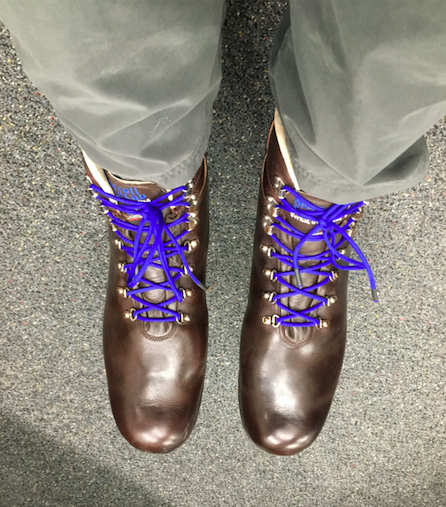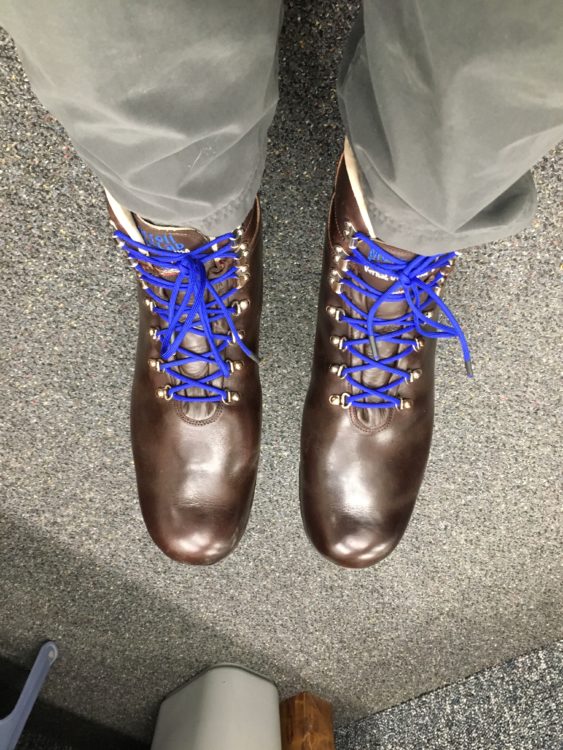
They say every good narrative is a journey.
Los Angeles Times reporter Thomas Curwen starts his by looking down. Literally. Here's the lede to his unexpected story about boots, which is really, as the headline notes, a story about "love, death and leather:"
All my life I've looked down on them.
How could I not?
From there, Curwen takes us along as he travels from Los Angeles to Vernal, Utah, to meet revered boot maker Randy Merrell, and beg some hand-made hope for his impossible-to-fit feet. They are feet he calls "architectural wonders," "declarations," "emphatic dots" at the bottom of the "exclamation point" of his body. Or my favorite: "a breakaway republic."
I've met Curwen and have never noticed anything off or odd about his feet. Frankly, I've never noticed his feet at all. He seemed like a proportional guy to me. A very long, narrow guy, with the gangly angles of an Ichabod Crane or Abraham Lincoln. If I had bothered to ponder his feet, I would probably just think them appropriate in scale, a horizontal balance to his verticality.
But I never had to buy shoes for those feet. Curwen does. So, after "years of discord," he set out on a journey, seeking more than a painful detente with his feet. Here's where, he told me, that journey started:
"When I first started to think about this story — with a handful of notes — I came up with a working title, 'The Story of my Feet,' and a first sentence (which I rather loved): 'All my life I’ve looked down on them.'
"But I knew I needed more."
If this sounds like a light froth that gave a writer license to strain a few metaphors (and turn a shopping trip into an assignment), it is anything but. Rather, it becomes, in Merrell's deft hands as he feels the form of Curwen's feet and Curwen's deft hands as he feels the form of a story, a study in braided narrative. Curwen weaves his search for boots with the portrait of a boot-maker with the boot-makers search for meaning in loss.
There is much to study in what seems a simple piece: Foreshadow. A structure built on scenes. Pacing that moves up and down the ladder of abstraction, from rooted moments to lofty meditation, from emotion to explanation, from humor to pathos. Reporting that draws on the senses. Description that is both specific and metaphorical. Suspense and surprise. All in a story about, ostensibly, boots, that then becomes a story about how we carry the weight of our burdens.
But pause for a moment, as you make your way through the steps of this story, at the second section. It's set off from the opening passage by a delicate design dingbat of four dots. Curwen introduces us to his feet, the reason for his journey, and then, briefly, to Randy Merrell. At this point, impatient readers might be wondering why they should give a hangnail about Curwen's feet, or if they are being lured into a pedestrian profile by a clever writerly gimmick. Until Curwen himself pauses for three paragraphs that frames the entire piece in a context that is both intimate (even bawdy) and universal:
Philosophers say that eyes are the gateway to the soul. I would argue it’s the feet, this strange collection of ligaments, tendons, muscles and bones, partners in evolution from a knuckle-dragging past to four-minute miles.
Feet have a talismanic hold on our psyches. Reflexologists manipulate them, and inquisitors flog them. Parents play piggy with baby’s toes, and lovers suck on them.
Still, so far from our brains and so close to our hearts, they bear our weight and carry us forward, but they weigh us down. Itchy, sweaty, lumpy, they contract fungus, develop hammer toes, bunions and corns. They attract sock lint, and they sweat.
Context can be an elusive thing for writers. We reach and reach for the higher meaning of a specific story. Sometimes we never grab anything worthy. Sometimes we overreach.
One of the things I have learned about Curwen, and all good writers, is that they keep reaching for ways to play with and improve their craft. I happened into the boot-maker journey through a post Curwen put on a Facebook group we are part of, where he said he decided to let a story take him, structurally, where it wanted; he wasn't sure if it worked, but he dared to try. Intrigued, I read the story, then sent Curwen a few questions, about those lofty contextual grafs and then, inevitably, a few other things. Here's our exchange:
What was the thinking behind those grafs, both in terms of purpose and placement, in a story that was otherwise the braid of two intimate, personal journeys: Yours and Merrell’s?
I had my story, and I had Randy Merrell’s story. I wasn’t sure how they would come together, so I wanted to hit a more universal note. I wanted to put the foot into readers’ hands, and I knew this would be something of an edgy proposition. Which was of course the appeal.
Feet are a strangely intimate, profoundly sensitive part of our anatomy. When Merrell held my feet, it felt odd. I told myself to relax. Later when I asked around, I learned that my reaction wasn’t unusual. I was intrigued. What is it about feet that make them so personal and private? It got me thinking anatomically, evolutionarily, psychologically.
As for the placement in the story — the opening of the second section — I wanted to hit a more authoritative tone after the colloquial tone of the opening. Plus, I wanted this story to be surprising, if not slightly disorienting. It would mean taking a few leaps and bounds throughout the narrative, eschewing hand-holding transitions and abandoning pieces of scaffolding.
When you did the joke about “last,” did you think of, and reject, being more obvious: “First comes the last.”
I struggled with this section of the story. I had so much material on how Merrell made my boots: the pedigree of the leather, the type of thread, the scissoring of the patterns, fastening the soles. But the more I looked at this aspect of the story, the more bored I got with it. Don’t get me wrong: I really like stories about craft and have written a few (see “behind the story” essay that accompanies the story).
But I had other things to do in this story. So I had to come up with a short-hand for the work itself. Shape-shifting helped.
As for my sentence — “It begins with the last.” — I had the hardest time with that damn little sentence. I had it in my head that this was the right syntax, but I didn’t know if the joke was clear enough. So I added the aside (“rim shot, please”), just to carry that tone.
I’d love to know how you came to the ending you did. Endings are super hard for a lot of writers. (Me!) Yours did not lead to the expected or predictable place … or at least where I thought it might land. No overt reference back to shoes or feet or the paths we walk. In other words, nothing pat. Instead, it left me a bit surprised, and therefore thoughtful. Can you give me a bit of insight into your thinking about that ending, and endings in general?
I love this question because this is what truly consumed me throughout the reporting. I knew I had the components of a pretty interesting story, and I was emotionally attached to all of them. There were my feet (and my curious relationship to them), and then there was Merrell’s incredible story (loss upon loss, faith, philosophy and his understanding of it all).
I struggled to put them together when it came to me: Writing is truly a mysterious process, and it was a gift (from the muse?) to figure out that acceptance was the common thread between these clodhoppers of mine and his losses. One seems so superficial and the other so profound, so I knew I had to hit the right tone.
It helped that long ago, I had read the story about Dan Quisenberry, a famous sidearm pitcher with the Kansas City Royals who not long after retiring was diagnosed with a brain tumor that proved to be fatal. During his treatments, he said: “I never ask, ‘Why me?’ Instead, ‘Why not me?’”
We often think of our lives as being exceptional. We shake our fists at fate, but to claim exceptionality is not only arrogant — it is not the way the world works. Quisenberry’s story came to mind when I wondered how Merrell could be so equanimous in the course of all the loss that he had experienced.
It proved to be a lesson that I needed to learn as well.



